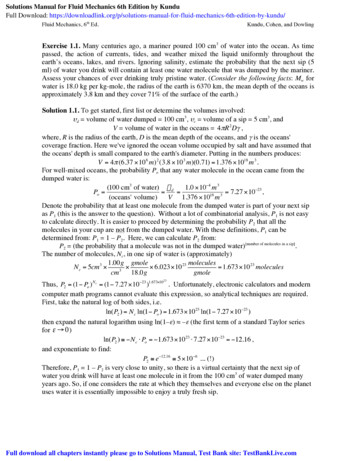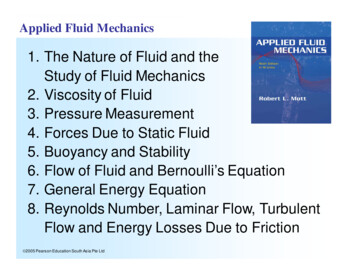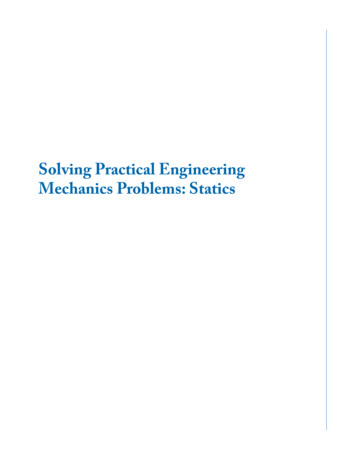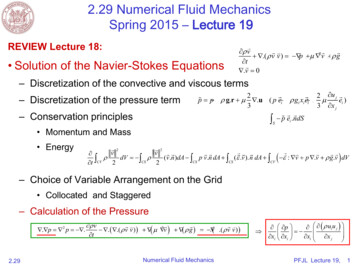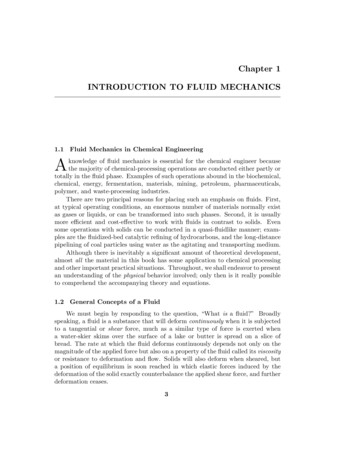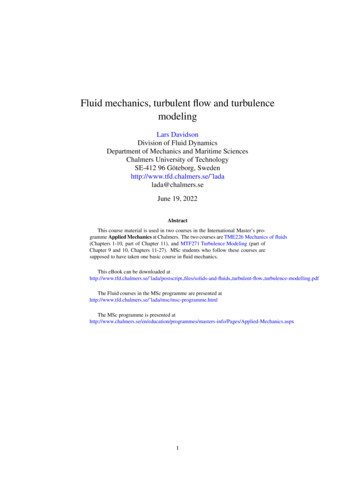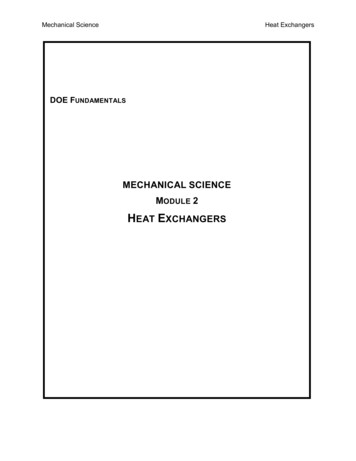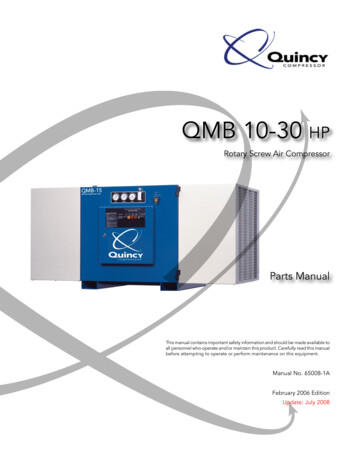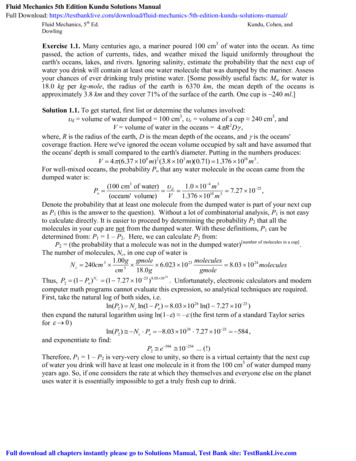
Transcription
Fluid Mechanics 5th Edition Kundu Solutions ManualFull Download: 5th-edition-kundu-solutions-manual/Fluid Mechanics, 5th Ed.DowlingKundu, Cohen, andExercise 1.1. Many centuries ago, a mariner poured 100 cm3 of water into the ocean. As timepassed, the action of currents, tides, and weather mixed the liquid uniformly throughout theearth's oceans, lakes, and rivers. Ignoring salinity, estimate the probability that the next cup ofwater you drink will contain at least one water molecule that was dumped by the mariner. Assessyour chances of ever drinking truly pristine water. [Some possibly useful facts: Mw for water is18.0 kg per kg-mole, the radius of the earth is 6370 km, the mean depth of the oceans isapproximately 3.8 km and they cover 71% of the surface of the earth. One cup is 240 ml.]Solution 1.1. To get started, first list or determine the volumes involved: d volume of water dumped 100 cm3, c volume of a cup 240 cm3, andV volume of water in the oceans 4 R 2 D ,where, R is the radius of the earth, D is the mean depth of the oceans, and is the oceans'coverage fraction. Here we've ignored the ocean volume occupied by salt and have assumed thatthe oceans' depth is small compared to the earth's diameter. Putting in the numbers produces: V 4 (6.37 106 m)2 (3.8 103 m)(0.71) 1.376 1018 m 3 .For well-mixed oceans, the probability Po that any water molecule in the ocean came from thedumped water is:(100 cm3 of water) d1.0 10 4 m 3Po 7.27 10 23 , 183(oceans' volume)V 1.376 10 mDenote the probability that at least one molecule from the dumped water is part of your next cupas P1 (this is the answer to the question). Without a lot of combinatorial analysis, P1 is not easyto calculate directly. It is easier to proceed by determining the probability P2 that all the in your cup are not from the dumped water. With these definitions, P can bemolecules1determined from: P1 1 – P2. Here, we can calculate P2 from:P2 (the probability that a molecule was not in the dumped water)[number of molecules in a cup].The number of molecules, Nc, in one cup of water is1.00g gmolemoleculesN c 240cm 3 6.023 10 23 8.03 10 24 molecules3cm18.0ggmole24Thus, P2 (1 Po ) N c (1 7.27 10 23 ) 8.03 10 . Unfortunately, electronic calculators and moderncomputer math programs cannot evaluate this expression, so analytical techniques are required.First, take the natural log of both sides, i.e. ln(P2 ) Nc ln(1 Po ) 8.03 1024 ln(1 7.27 10 23 ) then expand the natural logarithm using ln(1– ) – (the first term of a standard Taylor seriesfor 0 )ln(P2 ) Nc Po 8.03 1024 7.27 10 23 584 , and exponentiate to find:P2 e 584 10 254 . (!) Therefore, P1 1 – P2 is very-very close to unity, so there is a virtual certainty that the next cup of water you drink will have at least one molecule in it from the 100 cm3 of water dumped manyyears ago. So, if one considers the rate at which they themselves and everyone else on the planet uses water it is essentially impossibleto get a truly fresh cup to drink.Full download all chapters instantly please go to Solutions Manual, Test Bank site: TestBankLive.com
Fluid Mechanics, 5th Ed.DowlingKundu, Cohen, andExercise 1.2. An adult human expels approximately 500 ml of air with each breath duringordinary breathing. Imagining that two people exchanged greetings (one breath each) manycenturies ago, and that their breath subsequently has been mixed uniformly throughout theatmosphere, estimate the probability that the next breath you take will contain at least one airmolecule from that age-old verbal exchange. Assess your chances of ever getting a truly freshbreath of air. For this problem, assume that air is composed of identical molecules having Mw 29.0 kg per kg-mole and that the average atmospheric pressure on the surface of the earth is 100kPa. Use 6370 km for the radius of the earth and 1.20 kg/m3 for the density of air at roomtemperature and pressure.Solution 1.2. To get started, first determine the masses involved.m mass of air in one breath density x volume 1.20kg /m 3 0.5 10 3 m 3 0.60 10 3 kgM mass of air in the atmosphere 4 R 2 (z)dzz 0Here, R is the radius of the earth, z is the elevationabove the surface of the earth, and (z) is the air density as function of elevation. From the law for static pressure in a gravitational field,dP dz g , the surface pressure,Ps, on the earth is determined from Ps P z (z)gdz soz 0P PM 4 R s 4 (6.37 10 6 m) 2 (10 5 Pa) 5.2 1018 kg .that:gwhere the pressure (vacuum) in outer space P 0, and g is assumed constant throughout the atmosphere. For a well-mixed atmosphere, the probability Po that any molecule in theatmosphere came from the age-old verbal exchange is 2 (mass of one breath)2m 1.2 10 3 kgPo 2.31 10 22 ,(mass of the whole atmosphere)M 5.2 1018 kgwhere the factor of two comes from one breath for each person. Denote the probability that atleast one molecule from the age-old verbal exchange is part of your next breath as P1 (this is theanswer to the question). Without a lot of combinatorial analysis, P1 is not easy to calculate It is easier to proceed by determining the probability P that all the molecules in yourdirectly.2next breath are not from the age-old verbal exchange. With these definitions, P1 can bedetermined from: P1 1 – P2. Here, we can calculate P2 from:P2 (the probability that a molecule was not in the verbal exchange)[number of molecules in a breath].The number of molecules, Nb, involved in one breath is0.6 10 3 kg 10 3 gmoleculesNb 6.023 10 23 1.25 10 22 molecules29.0g /gmolekggmole22Thus, P2 (1 Po ) N b (1 2.31 10 22 )1.25 10 . Unfortunately, electronic calculators and moderncomputer math programs cannot evaluate this expression, so analytical techniques are required.First, take the natural log of both sides, i.e.ln(P2 ) Nb ln(1 Po ) 1.25 1022 ln(1 2.31 10 22 ) then expand the natural logarithm using ln(1– ) – (the first term of a standard Taylor seriesfor 0 )ln(P2 ) Nb Po 1.25 1022 2.31 10 22 2.89 , and exponentiate to find:2
Fluid Mechanics, 5th Ed.DowlingKundu, Cohen, andP2 e 2.89 0.056 .Therefore, P1 1 – P2 0.944 so there is a better than 94% chance that the next breath you takewill have at least one molecule in it from the age-old verbal exchange. So, if one considers howoften they themselves and everyone else breathes, it is essentially impossible to get a breath of truly fresh air.
Fluid Mechanics, 5th Ed.DowlingKundu, Cohen, andExercise 1.3. In Cartesian coordinates, the Maxwell probability distribution, f(u) f(u1,u2,u3), ofmolecular velocities in a gas flow with average velocity U (U1,U2,U3) is m 3 2 m2 f (u) u U exp 2k B T 2 kB T where n is the number of gas molecules in volume V, m is the molecular mass, kB is Boltzmann’sconstant and T is the absolute temperature.a) Verify that U is the average molecular velocity, and determine the standard deviations ( 1, 12 23 2, 3) of each component of U using i (ui U i ) f (u)d u for i 1, 2, and 3. all u b) Using the molecular version of perfect gas law (1.21), determine n/V at room temperature T 295 K and atmospheric pressure p 101.3 kPa.c) Determine n for volumes V (10 m)3, 1 m3, and (0.1 m)3. d) For the ith velocity component,the standard deviation of the average, a,i, over n moleculesis a,i i n when n 1. For an airflow at U (1.0 ms–1, 0, 0), compute the relativeuncertainty, 2 a ,1 U1 , at the 95% confidence level for the average velocity for the three volumeslisted in part c).e) For the conditions specified in parts b) and d), what is the smallest volume of gas that ensures a relativeuncertainty in U of less than one percent? Solution 1.3. a) Use the given distribution, and the definition of an average: m 3 2 m2 3uave u f (u)d u u U d 3 u . u exp 2k B T 2 k B T – – – all uConsider the first component of u, and separate out the integrations in the "2" and "3" directions. m 3 2 m (u1 ) ave (u1 U1 ) 2 (u2 U 2 ) 2 (u3 U 3 ) 2 du1du2 du3 u1 exp 2k B T 2 k B T – – – 32 m m(u1 U1 ) 2 m(u2 U 2 ) 2 m(u3 U 3 ) 2 uexp duexp duexp du3 11 2 2k B T – 2kB T2k B T – 2 k B T – The integrations in the "2" and "3" directions are equal to: 2 kB T m , so m 1 2 m(u1 U1 ) 2 (u) uexp du1 11 ave 2k B T 2 k B T – 12) m 2k T changes this integral to:The change of integration variable to (u U 1211B12 1 2k B T 12(u) Uexp d 0 U1 U1 , 1ave1 – m where the first term of the integrandis an odd function integrated on an even interval so its contribution is zero. This procedure is readily repeated for the other directions to find (u2)ave U2, and (u3)ave U3. Using the same simplifications and change of integration variables produces: m 3 2 m 22 1 (u1 U1 ) 2 (u2 U 2 ) 2 (u3 U 3 ) 2 du1du2 du3 (u1 U1 ) exp 2k B T 2 k B T – – –
Fluid Mechanics, 5th Ed.DowlingKundu, Cohen, and m 1 2 m(u1 U1 ) 2 1 2kB T 222 (u U)exp du exp d . 111 2 kT2kTm B – – BThe final integral over is: 2 , so the standard deviations of molecular speed are 1 kB T m 2 3 ,12 where the second two equalities follow from repeating this calculation for the second and thirddirections. b) From (1.21), n V p kB T (101.2kPa) [1.381 10 23 J /K 295K] 2.487 1025 m 3 n 2.487 1010 for V 103 m3 10–15 m3c) From n/V from part b):n 2.487 107 for V 1.0 m3 10–18 m3n 2.487 104 for V 0.001 m3 10–21 m3 d) From (1.22), the gas constant is R (kB/m), and R 287 m2/s2K for air. Compute: 1 212122 a,1 U1 2 kB T m n 1m / s 2 RT n 1m /s 2 287 295 n 582 n . Thus, forV 10–15 m3 : 2 a,1 U1 0.00369,–18 3V 10 m : 2 a,1 U1 0.117, andV 10–21 m3 : 2 a,1 U1 3.69.e) To achieve1% we need n (582/0.01)2 3.39 109, and this a relative uncertainty of-16 3corresponds to a volume of 1.36 10 m which is a cube with side dimension 5 m.
Fluid Mechanics, 5th Ed.DowlingKundu, Cohen, andExercise 1.4. Using the Maxwell molecular velocity distribution given in Exercise 1.3 with U 0, determine the average molecular speed 1 223v u f (u)d u all u and compare it with c speed ofsound in a perfect gas under the same conditions. Solution 1.4. Use the specified form for v and the Maxwell distribution m 3 2 2 m 22322v u f (u)d u u12 u22 u32 du1du2 du3 . u1 u2 u3 exp 2k B T 2 k B T – – – all u This can be re-arranged and expandedinto a total of nine one-variable integrations:32 m mu12 mu22 mu32 2v 2 uexp duexp duexp du3 11 2 2k B T – 2k B T – 2k B T 2 k B T – m 3 2 mu12 2 mu22 mu32 du1 u2 exp du2 exp du3 exp 2k B T – 2k B T – 2k B T 2 kB T – m 3 2 mu12 mu22 2 mu32 du1 exp du2 u3 exp du3 . exp 2k B T – 2k B T – 2k B T 2 kB T – arrangement, the six off-diagonal integrals are equal to 2 k T m 1 2 and the three onIn this B diagonal integrals are equal to 2kB T m 2 . Thus, 32 m 2 kB T 2k B T 3 2 2k B T 3 2 2k B T 3 2 3k T2v , or v 2 B . m m 2m 2 k B T m m so v 3RT and this speed has the same temperature dependence but isFrom (1.22), R (kB/m)a factor of 3 larger than the speed of sound in a perfect gas: c RT . 32
Fluid Mechanics, 5th Ed.DowlingKundu, Cohen, andExercise 1.5. By considering the volume swept out by a moving molecule, estimate how themean-free path, l, depends on the average molecular cross section dimension d and themolecular number density n for nominally spherical molecules. Find a formula for ln 1 3 ( theratio of the mean-free path to the mean intermolecular spacing) in terms of the molecular volume( d 3 ) and the available volume per molecule ( 1 n ). Is this ratio typically bigger or smaller thanone? Solution 1.5. The combined collision cross section for two spherical molecules having diameter d is d 2 . The mean free path l is the average distance traveled by a molecule between collisions.Thus, the average molecule should experience one collision whensweeping a volume equal to d 2l . If the molecular number density isn , then the volume per molecule is n 1, and the mean intermolecular dspacing is n 1 3 . Assuming that the swept volume necessary toproduce one collision is proportional to the volume per molecule produces: d 2l C n or l C n d 2 , where C is a dimensionless constant presumed to be of order unity. The dimensionless version ofthis equation is:mean free pathl 1 3 l n 1 3 mean intermolecular spacing n Cn 2 3 d 2 C n d 3 23 n 1 2 3 volume per molecule 2 3 C 3 C , molecular volume d where all numerical constants like have been combined into C. Under ordinary conditions ingases, the molecules are not tightly packed so l n 1 3 . In liquids, the molecules are tightlypacked so l n 1 3 .
Fluid Mechanics, 5th Ed.DowlingKundu, Cohen, andExercise 1.6. In a gas, the molecular momentum flux (MFij) in the j-coordinate direction thatcrosses a flat surface of unit area with coordinate normal direction i is:nMFij mui u j f (u)d 3 u where f(u) is the Maxwell distribution given in Exercise 1.3. For aV all uperfect gas that is not moving on average (i.e. U 0), show that MFij p, the pressure, when i j, and that MFij 0, when i j. Solution 1.6. Start from the given equation using the Maxwell distribution:32 m nnm m 3MFij mui u j f (u)d u u12 u22 u32 du1du2 du3 ui u j exp V all uV 2 kB T – – – 2kB T and first consider i j 1, and recognize nm/V as the gas density (see (1.22)). m 3 2 2 m MF11 u12 u22 u32 du1du2 du3 u1 exp 2k B T 2 k B T – – – 32 m 2 mu12 mu22 mu32 du1 exp du2 exp du3 u1 exp 2k B T – 2k B T – 2k B T 2 kB T – The first integral is equal to 2k T m 3 2 2 while the second two integrals are each equal toB 2 kB T m 12. Thus: m 3 2 2k B T 3 2 2 k B T 1 2 2 k B T 1 2k TMF11 B RT p m 2 k B T m 2 m m where kB/m R from (1.22). This analysis may be repeated with i j 2, and i j 3 to find:MF22 MF33 p, as well.Now consider the case i j. First note that MFij MFji because the velocity product under the triple integral may be written in either order u u u u , so there are only three cases ofi jj iinterest. Start with i 1, and j 2 to find: m 3 2 m MF12 u12 u22 u32 du1du2 du3 u1u2 exp 2k B T 2 k B T – – – 3222 m mu1 mu2 mu32 uexp duuexp duexp du3 11 22 2k B T – 2k B T – 2k B T 2 kB T – Here we need only consider the first integral. The integrand of this integral is an odd functionbecause it is product of an odd function, u1, and an even function, exp mu12 2kB T . The integral of an odd function on an even interval [– , ] is zero, so MF12 0. And, this analysismay be repeated for i 1 and j 3, and i 2 and j 3 to find MF13 MF23 0.
Fluid Mechanics, 5th Ed.DowlingKundu, Cohen, andExercise 1.7. Consider the viscous flow in a channel of width 2b. The channel is aligned in thex-direction, and the velocity u in the x-direction at a distance y from the channel centerline is2given by the parabolic distribution u(y) U 0 1 y b . Calculate the shear stress as a function y, , b, and Uo. What is the shear stress at y 0? y 2 dudy Solution 1.7. Start from (1.3): U o 1 –2 U o 2 . At y 0 (the location ofdydy b b m2 Uo b .maximum velocity) 0. At At y b (the locations of zero velocity),
Fluid Mechanics, 5th Ed.DowlingKundu, Cohen, andExercise 1.8. Estimate the height to which water at 20 C will rise in a capillary glass tube 3 mmin diameter that is exposed to the atmosphere. For water in contact with glass the wetting angle isnearly 90 . At 20 C, the surface tension of an water-air interface is 0.073 N/m. (Answer: h 0.99 cm.)Solution 1.8. Start from the result of Example 1.1.2 sin 2(0.073N /m)sin(90 )h 9.92mm3 gR(10 kg /m 3 )(9.81m /s2 )(1.5 10 3 m)
Fluid Mechanics, 5th Ed.DowlingKundu, Cohen, andExercise 1.9. A manometer is a U-shaped tube containing mercury of density m. Manometersare used as pressure measuring devices. If the fluid in the tank A has a pressure p and density ,then show that the gauge pressure in the tank is: p patm mgh ga. Note that the last term onthe right side is negligible if m. (Hint: Equate the pressures at X and Y.)Solution 1.9. Start by equating the pressures at X and Y.pX p ga patm mgh pY.Rearrange to find:p – patm mgh – ga.
Fluid Mechanics, 5th Ed.DowlingKundu, Cohen, andExercise 1.10. Prove that if e(T, ) e(T) only and if h(T, p) h(T) only, then the (thermal)equation of state is (1.22) or p kT. Solution 1.10. Start with the first member of (1.18): de Tds – pd , and rearrange it: s s 1pds de d de d , e eTTwhere the second equality holds assuming the entropy depends on e and . Here we see that:1 s p s , and .T e T e s s Equality of the crossed second derivatives of s, , implies: e e e e 1 T p T . e e 1 T 1 T However, if e depends only on T, then ( / )e ( / )T, thus 0 , so e T p T 0 , and this can be integrated once to find: p/T f1( ), where f1 is an undetermined e function. Now repeat this procedure using the second member of (1.18), dh Tds dp. s s 1 ds dh dp dh dp . h pTT p h1 s s Here equality of the coefficients of the differentials implies: , and .T h pT p h 1 T T So, equality of the crossed second derivatives implies: . p h h p 1 T 1 T Yet, if h depends only on T, then ( / p)h ( / p)T, thus 0 , so p h p T T 0 , and this can be integrated once to find: /T f2(p), where f2 is an undetermined h pfunction. Collecting the two results involving f1 and f2, and solving for T produces:p or pf 2 (p) f1( ) k , T f1 ( )f 2 ( p)where k must be is a constant since p and are independent thermodynamic variables.Eliminating f1 or f2 from either equation of the left, produces p kT.And finally, using both versions of (1.18) we can write: dh – de dp pd d(p ). When e and h only depend on T, then dh CpdT and de CvdT, sodh – de (Cp – Cv)dT d(p ) kdT , thus k Cp – Cv R,where R is the gas constant. Thus, the final result is the perfect gas law: p kT/ RT.
Fluid Mechanics, 5th Ed.DowlingKundu, Cohen, andExercise 1.11. Starting from the property relationships (1.18) prove (1.25) and (1.26) for areversible adiabatic process when the specific heats Cp and Cv are constant.Solution 1.11. For an isentropic process: de Tds – pd –pd , and dh Tds dp dp.Equations (1.25) and (1.26) apply to a perfect gas so the definition of the specific heat capacities(1.14), and (1.15) for a perfect gas, dh CpdT, and de CvdT , can be used to form the ratiodh/de:d d dpdh Cp dT Cp dp .or pde Cv dT Cvpd The final equality integrates to: ln(p) ln( ) const which can be exponentiated to find:p const. ,which is (1.25). The constant may be evaluated at a reference condition po and o to find: p po o and this may be inverted to put the density ratio on the left1 o p po , which is the second member of (1.26). The remaining relationship involving the temperature isfound by using the perfect gas law, p RT, to eliminate p/RT:1 1 p ( 1) p RT pTo p Tp p , or o po RTo poT po To po po po which is the first member of (1.26).
Fluid Mechanics, 5th Ed.DowlingKundu, Cohen, andExercise 1.12. A cylinder contains 2 kg of air at 50 C and a pressure of 3 bars. The air iscompressed until its pressure rises to 8 bars. What is the initial volume? Find the final volume forboth isothermal compression and isentropic compression.Solution 1.12. Use the perfect gas law but explicitly separate the mass M of the air and thevolume V it occupies via the substitution M/V:p RT (M/V)RT.Solve for V at the initial time:Vi initial volume MRT/pi (2 kg)(287 m2/s2K)(273 50 )/(300 kPa) 0.618 m3.For an isothermal process:Vf final volume MRT/pf (2 kg)(287 m2/s2K)(273 50 )/(800 kPa) 0.232 m3.For an isentropic process:1 1 1.4V f Vi pi p f 0.618m 3 300kPa 800kPa 0.307m 3 .
Fluid Mechanics, 5th Ed.DowlingKundu, Cohen, andExercise 1.13. Derive (1.29) starting from the arguments provided at the beginning of Section1.10 and Figure 1.8. Solution 1.13. Take the z axis vertical, and consider a small fluid element m of fluid havingvolume V that starts at height z0 in a stratified fluid medium having a vertical density profile (z), and a vertical pressure profile p(z). Without any vertical displacement, the small mass andits volume are related by m (z0) V. If the small mass is displaced vertically a small distance via an isentropic process, its density will change isentropically according to: a (z0 ) (z0 ) d a dz .where d a/dz is the isentropic density at z0. For a constant m, the volume of the fluid elementwill be: m m m 1 d a V . 1 a (z0 ) d a dz . (z0 ) (z0 ) dz The background density at z0 is: (z0 ) (z0 ) d dz .If g is the acceleration of gravity, the (upward) buoyant force on the element at the vertically displaced location will be g (z0 ) V, while the (downward) weight of the fluid element at anyvertical location is g m. Thus, a vertical application Newton's second law implies: d 2 m 1 d a m 2 g (z0 ) V g m g (z0 ) d dz . . g m , 1 dt (z0 ) (z0 ) dz where the second equality follows from substituting for (z0 ) and V from the aboveequations. Multiplying out the terms in (,)-parentheses and dropping second order termsproduces:d 2 g m d g m d ag m d d a m 2 g m . g m dt (z0 ) dz (z0 ) dz (z0 ) dz dz Dividing by m and moving all the terms to the right side of the equation produces:d 2 g d d a 0dt 2 (z0 ) dz dz Thus, for oscillatory motion at frequency N, we must haveg d d a N2 , (z0 ) dz dz which is (1.29).
Fluid Mechanics, 5th Ed.DowlingKundu, Cohen, andExercise 1.14. Starting with the hydrostatic pressure law (1.8), prove (1.30) without usingperfect gas relationships.Solution 1.14. The adiabatic temperature gradient dTa/dz, can be written terms of the pressuregradient: T dTa T dp g dz p s dz p swhere the hydrostatic law dp/dz – g has been used to reach the second equality. Here, the finalpartial derivative can be exchanged for one involving 1/ and s, by considering: h h dh ds dp Tds dp . s p p s h h Equality of the crossed second derivatives of h, , implies: p s p s s p s p T T s , p s s p T p s p T p T pwhere the second two equalities are mathematicalmanipulations that allow the introduction of h s 1 , and Cp T . T p T p T p T p Thus, T C g T s dTa g g g p . dz p T TTC ppps
Fluid Mechanics, 5th Ed.DowlingKundu, Cohen, andExercise 1.15. Assume that the temperature of the atmosphere varies with height z as T T0 g/KR T0 Kz where K is a constant. Show that the pressure varies with height as p p0 , where T0 Kz g is the acceleration of gravity and R is the gas constant for the atmospheric gas.Solution 1.15. Start with the hydrostatic and perfect gas laws, dp/dz – g, and p RT, eliminate the density, and substitute in the given temperature profile to find:dpppdpgdz. g g g or dzRTR(T0 Kz)pR (T0 Kz)The final form may be integrated to find:gln p ln T0 Kz const.RK At z 0, the pressure must be p0, therefore:gln p0 ln T0 const.RK equation above and invoking the properties of logarithms produces:Subtracting this from the p g T0 Kz ln ln pRK T0 0 Exponentiating produces: g/KRg/KR T0 p T0 Kz , which is the same as: p p0 .p0 T0 T0 Kz
Fluid Mechanics, 5th Ed.DowlingKundu, Cohen, andExercise 1.16. Suppose the atmospheric temperature varies according to: T 15 0.001z, whereT is in degrees Celsius and height z is in meters. Is this atmosphere stable?Solution 1.16. Compute the temperature gradient:dT d C C. (15 0.001z) 0.001 1.0dz dzmkmFor air in the earth's gravitational field, the adiabatic temperature gradient is:dTag T (9.81m /s2 )(1/T)T C 9.8.22dzCp1004m /s Ckm Thus, the given temperature profile is stable because the magnitude of its gradient is less thanthe magnitude of the adiabatic temperature gradient.
Fluid Mechanics, 5th Ed.Dowling Kundu, Cohen, andExercise 1.17. Consider the case of a pure gas planet where the hydrostatic law is:zdp dz (z)Gm(z) z 2 . Here G is the gravitational constant, and m(z) 4 o ( ) 2 d is theplanetary mass up to distance z from the center of the planet. If the planetary gas is perfect withgas constant R, determine (z) and p(z) if this atmosphere is isothermal at temperature T. Arethese vertical profiles of and p valid as z increases without bound?Solution 1.17. Start with the given relationship for m(z), differentiate it with respect to z, and usethe perfect gas law, p RT to replace the with p. dm d zp(z) 4 ( ) 2 d 4 z 2 (z) 4 z 2.dz dz 0RT Now use this and the hydrostatic law to obtain a differential equation for m(z),dpGm(z)d RT dm 1 dm Gm(z). (z) 2 2dzzdz 4 z dz 4 z 2 dz z 2 After recognizing T as a constant, the nonlinear second-order differential equation for m(z)simplifies to:RT d 1 dm 1 dm. 2 4 mG dz z dz zdzThis equation can be solved by assuming a power law: m(z) Azn. When substituted in, this trialsolution produces:RT d 2RTn 1 n 3 Anz n 4 z 4 A2nz 2n 1. z Anz G dzGMatching exponents of z across the last equality produces: n – 4 2n – 5, and this requires n 1.For this value of n, the remainder of the equation is:RTRT 2 Az 3 z 4 A 2z1 , which reduces to: A 2 . GGThus, we have m(z) 2RTz/G, and this leads to:2RT 12R 2T 2 1,and. (z) p(z) 2G 4 z 2G4 z Unfortunately, these profiles are not valid as z increases without bound, because this leads to anunbounded planetary mass.
Fluid Mechanics 5th Edition Kundu Solutions ManualFull Download: 5th-edition-kundu-solutions-manual/Fluid Mechanics, 5th Ed.DowlingKundu, Cohen, andExercise 1.18. Consider a heat-insulated enclosure that is separated into two compartments ofvolumes V1 and V2, containing perfect gases with pressures and temperatures of p1, p2, and T1, T2,respectively. The compartments are separated by an impermeable membrane that conducts heat(but not mass). Calculate the final steady-state temperature assuming each gas has constantspecific heats.Solution 1.18. Since no work is done and no heat is transferred out of the enclosure, the finalenergy Ef is the sum of the energies, E1 and E2, in the two compartments.E1 E2 Ef implies 1V1Cv1T1 2V2Cv2T2 ( 1V1Cv1 2V2Cv2)Tf,where the Cv's are the specific heats at constant volume for the two gases. The perfect gas lawcan be used to find the densities: 1 p1/R1T1 and 2 p2/R2T2, sop1V1Cv1/R1 p2V2Cv2/R2 (p1V1Cv1/R1T1 p2V2Cv2/R2T2)Tf.A little more simplification is possible, Cv1/R1 1/( 1 – 1) and Cv2/R1 1/( 2 – 1). Thus, the finaltemperature is:p1V1 ( 1 1) p2V2 ( 2 1).Tf p1V1 ( 1 1)T1 p2V2 ( 2 1)T2 Full download all chapters instantly please go to Solutions Manual, Test Bank site: TestBankLive.com
Fluid Mechanics 5th Edition Kundu Solutions Manual, Fluid Mechanics, 5thEd. Kundu, Cohen, and Dowling , Exercise 1.1. Many centuries ago, a mariner poured 100 cm3of water into the ocean. As time passed, the action of currents, tides, and weather mixed the liquid uniformly throughout the earth's oceans, lakes, and rivers.
